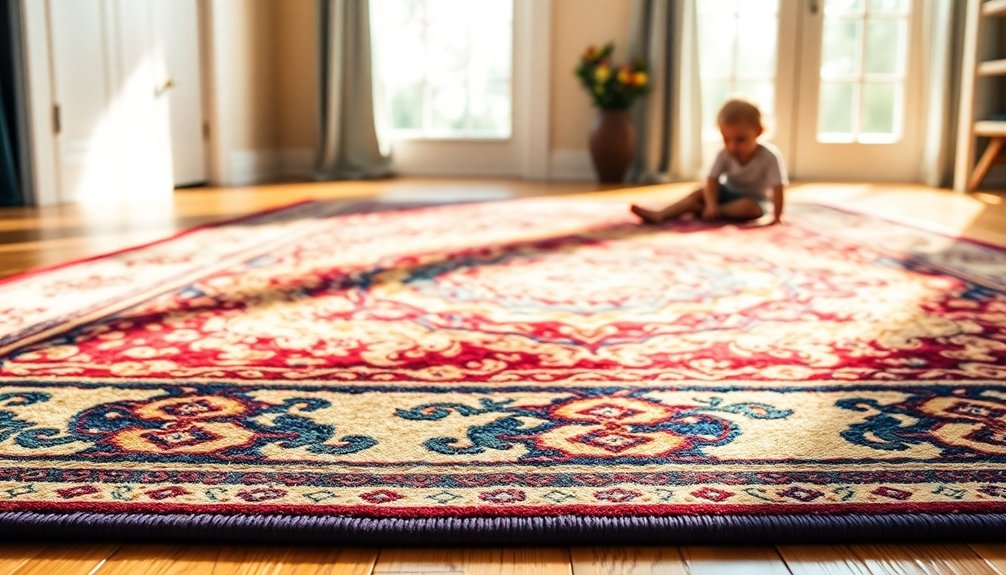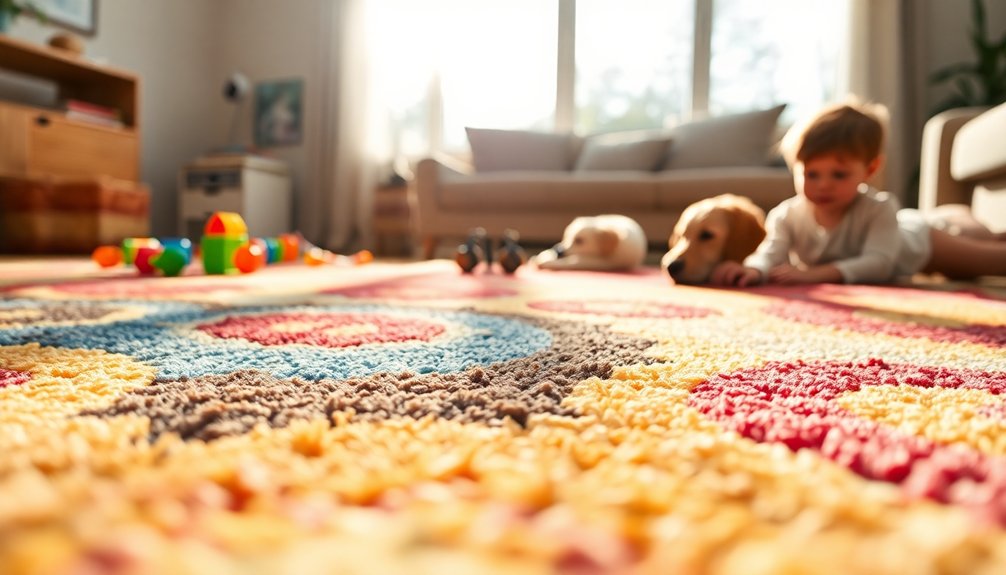Polypropylene rugs are generally safe for your home, but there are some important factors to consider. They can emit volatile organic compounds (VOCs) when new, which might cause headaches, so good ventilation is recommended during and after installation. Some people might also experience allergic reactions from certain dyes. However, these rugs are hypoallergenic, durable, and easy to clean, making them a great fit for high-traffic areas. To maximize safety and comfort, look for rugs with certifications like GREENGUARD Gold. You'll discover more ways to ensure your home remains a safe haven.
Key Takeaways
- Polypropylene rugs are generally safe but can emit VOCs during off-gassing, potentially causing headaches and respiratory irritation.
- Hypoallergenic properties help reduce dust and allergens, improving indoor air quality for sensitive individuals.
- Stain-resistant and water-resistant features make cleaning easy, essential for homes with children and pets.
- Look for certifications like GREENGUARD Gold to ensure rugs meet safety and environmental standards.
- Consider environmental impacts, as polypropylene is non-biodegradable and contributes to plastic waste in oceans.
Understanding Polypropylene Rugs
Polypropylene rugs offer a durable and versatile flooring solution for your home. Made from synthetic fibers derived from petroleum, these rugs are known for their outstanding resistance to wear and tear. This durability makes them perfect for high-traffic areas, where they can withstand heavy footfall without showing signs of damage.
Plus, their stain-resistant and water-resistant properties mean you won't have to worry about spills ruining your decor. Cleaning is a breeze; just use a mild detergent and water.
Available in a wide range of colors and designs, polypropylene rugs can easily mimic natural fibers, providing you with numerous options to match your home decor.
They're also hypoallergenic, making them a safe choice for allergy sufferers since they don't trap dust and allergens like traditional rugs can. The manufacturing process of polypropylene rugs generally avoids harmful substances, ensuring they're safe for indoor use.
With all these benefits, it's no wonder polypropylene rugs are gaining popularity as a practical and stylish flooring choice for any room in your home.
As a thermoplastic polymer classified as plastic #5, polypropylene rugs are recyclable and exhibit lower toxicity compared to many other plastics.
Health and Safety Risks
While polypropylene rugs are popular for their durability and design, they do come with some health and safety risks that you should be aware of. One concern is the emission of volatile organic compounds (VOCs) during off-gassing, which can trigger headaches and respiratory issues, especially in sensitive individuals.
If you're placing a new rug in a poorly ventilated space, you might want to reconsider its placement.
Although polypropylene rugs are generally considered hypoallergenic, certain dyes and finishes can still provoke allergic reactions in some people. You might experience skin irritations from direct contact with the synthetic materials used in these rugs.
Additionally, inhaling fine particles can lead to respiratory irritation, particularly for those with preexisting conditions.
To minimize these potential health risks, it's crucial to ensure proper ventilation when introducing new polypropylene rugs into your home. This can help dissipate initial odors and reduce exposure to harmful VOCs.
As you weigh the safety of these rugs, you may also want to consider your own environmental responsibility and explore alternative options that align better with your health needs.
Benefits of Polypropylene Rugs

If you're looking for a practical and stylish flooring option, polypropylene rugs might just be the perfect choice for you. Made from synthetic fibers, these rugs offer a fantastic blend of durability and comfort, making them ideal for high-traffic areas like living rooms and entryways.
Their soft texture underfoot enhances your space while providing a lightweight solution for easy rearrangement.
One of the standout benefits of polypropylene rugs is their impressive resistance to stains and spills. This quality makes them an excellent option for households with children and pets, as you can easily clean them with mild detergent and water.
Plus, many polypropylene rugs are hypoallergenic and free from harmful substances, ensuring a safe environment for allergy sufferers and improving indoor air quality.
Affordability is another significant advantage. Polypropylene rugs typically cost less than natural fiber options, allowing you to achieve style and quality without breaking the bank.
With their durability, comfort, and ease of maintenance, polypropylene rugs are a smart investment for anyone seeking a stylish and practical flooring solution.
Additionally, many polypropylene rugs are made from eco-friendly materials, promoting sustainability and making them an environmentally conscious choice for homeowners.
Environmental Concerns
When considering polypropylene rugs, it's essential to acknowledge their environmental impact. While these rugs may be durable and affordable, they come with significant ecological concerns. The production process relies on fossil fuels, which contributes to greenhouse gas emissions and pollution of our oceans.
Additionally, polypropylene is non-biodegradable, meaning it can linger in landfills for centuries, worsening waste management issues.
Recycling options for polypropylene are limited and complicated, making it difficult for you to repurpose used rugs effectively. Although some manufacturers are starting to utilize recycled polypropylene in their products, this approach is still not widespread enough to make a substantial difference in sustainability.
The slow decomposition rate of polypropylene further amplifies the long-term ecological effects, raising questions about the overall safety and sustainability of these rugs. Furthermore, polypropylene accounts for approximately 16% of plastic waste in oceans, exacerbating the plastic pollution crisis and disrupting ecosystems.
As you contemplate your flooring choices, it's crucial to weigh these environmental concerns against the benefits. Ultimately, understanding the impact of polypropylene rugs can help you make informed decisions that align with your values, especially if you prioritize eco-friendly practices in your home.
Best Practices for Consumers

Understanding the environmental concerns associated with polypropylene rugs can guide you in making safer, more informed choices. Here are some best practices you should follow:
- Look for certifications: Choose polypropylene rugs with certifications like GREENGUARD Gold or OEKO-TEX Standard 100 to ensure low VOC emissions and safety for indoor use.
- Ensure proper ventilation: When you bring home a new rug, make sure to ventilate the area well. This helps mitigate any initial odors or off-gassing, promoting a healthier environment.
- Regular maintenance: Vacuum your rug regularly and perform spot cleaning with a mild detergent. This keeps the rug's integrity intact and reduces allergens over time.
- Research manufacturers: Investigate manufacturers to understand their production processes. Transparency can help you make informed decisions about the safety and sustainability of your rug.
- Opt for eco-friendly options: Consider rugs made from recycled polypropylene. This not only supports eco-friendly practices but also provides a safer choice if you're concerned about environmental impacts.
- Additionally, be aware of polypropylene's non-biodegradable nature and how it contributes to environmental concerns, such as accumulation in landfills and oceans, which makes proper disposal and recycling essential.
Frequently Asked Questions
Are Rugs Made of Polypropylene Safe?
When considering if rugs made of polypropylene are safe, you'll find they're hypoallergenic and often low in VOCs. Look for certifications like GREENGUARD Gold to ensure you're choosing a healthier option for your space.
What Is the Safety of Polypropylene?
When considering polypropylene's safety, you'll find it's generally safe for home use. It's free from harmful substances, hypoallergenic, and durable, but ensure you choose high-quality options to avoid any potential off-gassing or irritation.
What Rug Material Is Safest?
When choosing a rug, consider materials like polypropylene, which are hypoallergenic and resistant to mold. Look for certifications like OEKO-TEX or GREENGUARD to ensure the rug's safety for your indoor environment.
What Are the Disadvantages of Polypropylene Carpet?
Polypropylene carpets can absorb oils, making spills tough to clean. They've a low melting point, risking damage near heat sources. In high traffic areas, they may flatten, losing comfort and appearance over time.

